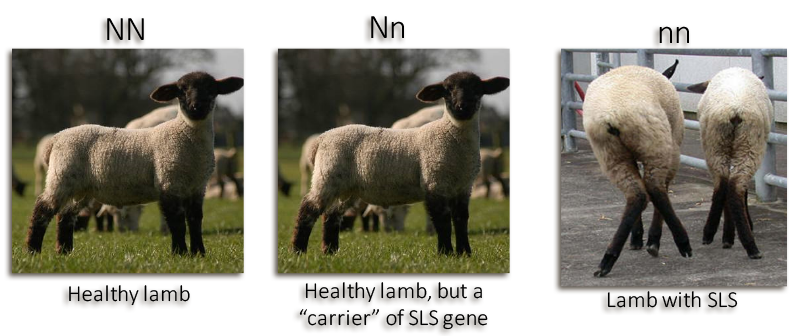 Relevancy and Engagement
agclassroom.org/or/
Relevancy and Engagement
agclassroom.org/or/
Companion Resource

Selectively Breeding Sheep: Punnet Square Practice
This activity can be a companion to a secondary genetics lesson allowing students to practice completing Punnett Squares. Students will learn about sheep production and how sheep breeders can use the Punnett Square to predict the likelihood of lambs in their flock inheriting a disease called Spider Lamb Syndrome or SLS.
Time to Complete
Materials
- Selectively Breeding Sheep student handout, 1 per person (Teacher KEY located on last 3 pages)
Procedures
Background Information:
All plants, animals, and humans are born with a different, but specific set of chromosomes which contain DNA. DNA stands for deoxyribonucleic acid. It is special, because it holds the code for every cell in your body. Every cell in your body uses DNA as an instruction manual to control the specific makeup of an organism. Within each string of DNA are sets of instructions called genes. A gene tells a cell how to make a specific protein. The proteins are used by the cell to perform certain functions, to grow, and to survive.
Inheritance is a biological process in which parents pass genes onto their children or offspring. Every offspring inherits genes from both of their biological parents and these genes in turn express specific traits. Some of these traits may be physical for example hair and eye color and skin color etc. On the other hand some genes may also carry the risk of certain diseases and disorders that may pass on from parents to their offspring.
Sheep are ruminant animals raised for meat and wool. According to the American Sheep Industry Association (2015), there are 5.28 million head of sheep in the United States. There are over 200 breeds of sheep that are selectively bred to serve specific purposes.
While sheep are bred for desirable traits, occasionally, other genetic diseases or disorders may be passed along to offspring as well. Spider Lamb Syndrome (SLS) in sheep is a recessive genetic disorder. It causes skeletal deformities including bent limbs and twisted spines. It is difficult for sheep breeders to eliminate the risk of SLS in a flock because parents of SLS lambs do not exhibit any symptoms. This is a recessive disorder, so both parents must carry a recessive allele in order for the lamb to be affected.
Sheep producers have the difficult task of using a combination of selective breeding techniques and DNA tests to eliminate this genetic trait from their animals. DNA tests can be expensive, so instead of purchasing DNA tests for an entire flock, breeders can test certain sheep and use Punnett Squares to predict the probability of other sheep in the flock of carrying the recessive allele.
Procedures:
- Facilitate a class discussion by asking, "How do a parents’ genes impact or affect possible offspring?" (Offspring will inherit traits from their parents and be similar to their parents.)
- Follow up by asking, "Why is it important to predict the phenotype of future offspring?" (If a parent possesses an undesirable Mendelian trait, you can see what the chances are that the offspring will also possess this undesirable characteristic.)
- Introduce sheep as an important managed livestock species in the U.S. Explain that over 200 different sheep breeds exist. This diversity is the result of both natural selection and selective breeding.

- Note: If needed, explain the difference between natural selection and selective breeding using the video, Artificial vs. Natural Selection.
- Display the graphic below of three potential genotypes in lambs. Explain that the lamb on the right has a recessive trait called Spider Lamb Syndrome. Ask:
- What do you notice about this lamb compared to the others? This lamb's legs are long and bent. It appears to have trouble walking.
- How do you think this condition would impact the lamb? The lamb likely struggles getting around. It does not move like a normal lamb and it’s difficult for it to do basic activities.
- How might this impact the sheep breeder? The lamb likely would not live as long as the average sheep. It would also not be able to be used for breeding.

- Using the information found in the Background section above, explain to students what Spider Lamb Syndrome is and how it is inherited.
- Give each student a copy of the attached Selectively Breeding Sheep student handouts. Allow students time to complete the worksheet.
File, Map, or Graphic
Author
Organization
Sources
Author Affiliations:
- Diana Webber: Albemarle High School, Charlottesville, Virginia
- Dr. Ron Lewis: University of Nebraska-Lincoln, Dept. of Animal Science
- Erin Ingram: University of Nebraska-Lincoln, IANR Science Literacy Initiative, National Center for Agricultural Literacy
- Molly Brandt: University of Nebraska-Lincoln, IANR Science Literacy Initiative, National Center for Agricultural Literacy
Image Sources: